Arts & Entertainment Business Community
‘The Old Church’ on Crescent Valley Drive for sale
The little roadside church on Crescent Valley Drive is a familiar landmark whose history dates back more than 100 years. Now it’s for sale, ready for its next chapter.
Community Sponsor
Community stories are made possible in part by Peninsula Light Co, a proud sponsor of Gig Harbor Now.
Built in 1908, the church has seen two congregations come and go. During the latter portion of its life, three different owners used it as an artist’s studio.
Enter the sanctuary and you’ll see light streaming in through tall windows, even on a cloudy day. Beneath a high vaulted ceiling, the old pulpit stands not only intact but in good shape given the building’s age. The alter is long gone, as are the pews. But an antique Linderman foot-pedal organ and a functioning wood-burning stove, age unknown, remain.
An adjacent room, formerly used for Sunday school, is the art studio of current owner Diane Davis. She has decided to sell “The Old Church,” as it’s known to many Gig Harbor locals, and is looking for a buyer who appreciates the charm and history of the place as much as she does.
“I want the right person who falls in love with it to buy it,” Davis said.
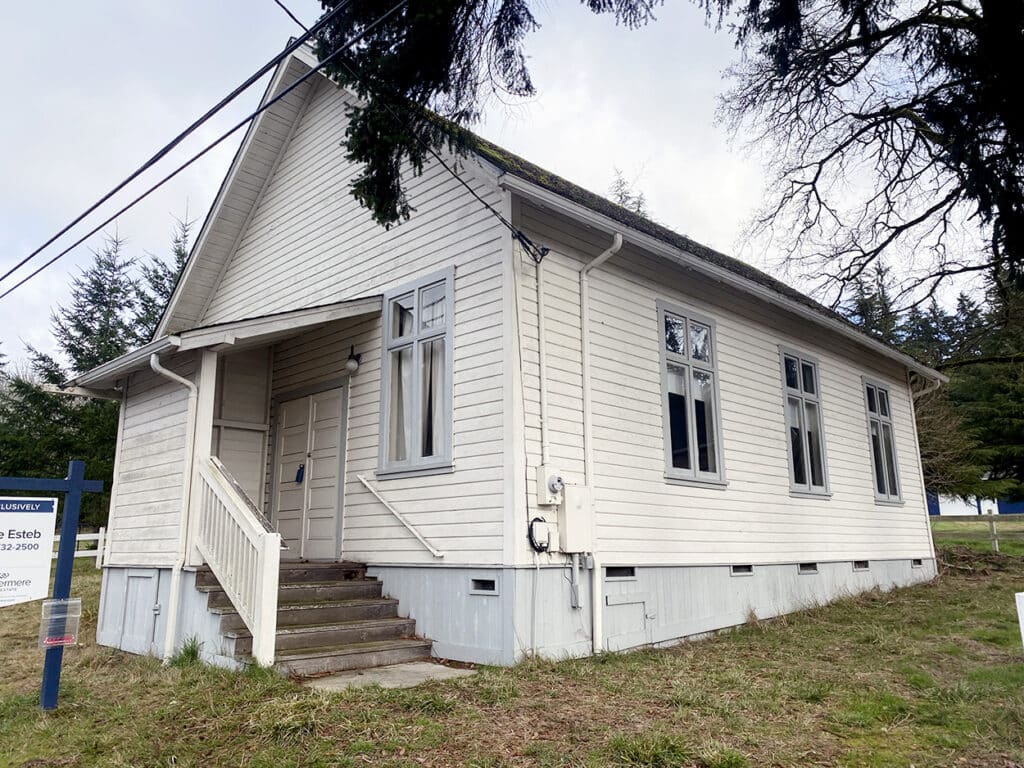
The former First Norwegian Lutheran Church of Gig Harbor (also called First Lutheran Church of Gig Harbor) is for sale. Built in 1908, the church was occupied by two congregations. Since 1953, it’s been used by three separate owners as an artist’s studio. The listing price is $175,000. Christina T Henry
Old Church and utilities
The church was built in 1908, according to the Pierce County Assessor. It sits in the heart of Crescent Valley, just outside city limits and a little over a mile from the harbor shore, according to the listing.
The property consists of a 1,250-square-foot, single-story building on a lot just over 4,000 square feet with off-street parking. The listing price is $175,000.
Utilities pose a significant challenge for the building’s future owner.
Water is available, according to the assessor, but is not connected. It has no sewer or septic.
The property is featured, among other listings, on Old House Dreams, which lists “specially selected historic real estate for old house enthusiasts.”
“Under current code, it could not be built as it stands today,” the Old House Dreams listing states. The listing cites a past letter from Washington Water Service, stating “water may be available upon petition.”
The church property is outside the city of Gig Harbor’s urban growth area. The city has no plans to extend the sewer line that far north, said Jeff Langhelm, public works director.
Septic options
A new owner could attempt to obtain a septic easement. But that depends on an adjacent property owner being willing to enter into a permanent agreement that would constitute a legal encumbrance on both properties and could affect the resale value of each, according to Tracy DiGiovanni of Shiers Law Firm in Port Orchard.
Use of the septic by the church property would also be subject to approval by the local health department and potentially other agencies.
Listing agent Michael Esteb of Windermere Gig Harbor said his client has turned down offers contingent on assessing feasibility for sewer and water.
“The ideal buyer would be somebody that could use it in its current condition without needing to add septic or water,” Esteb said, “such as somebody who wants to use it for a workshop that lived nearby, somebody that wanted to use it for an artist studio, somebody that wanted to restore it, use it for a church, are all things that would be good uses for it.”
Davis is hoping for a buyer who values the significance of the little building that holds so much local history.
Historical documents
The Crescent Valley Church of the Nazarene originally owned the little church. A congregation organized as First Norwegian Lutheran Church of Gig Harbor bought it on March 10, 1926. It was also called the First Lutheran Church of Gig Harbor, sometimes with the tagline “at Crescent Valley,” according to documents at the Harbor History Museum in Gig Harbor and the Archives and Special Collections Department at Pacific Lutheran University in Tacoma.
Among these is a book by Gig Harbor resident Douglas S. Knapp, 73, who was baptized in the Old Church and whose uncles were first among its parade of owners after it ceased to be a place of worship.
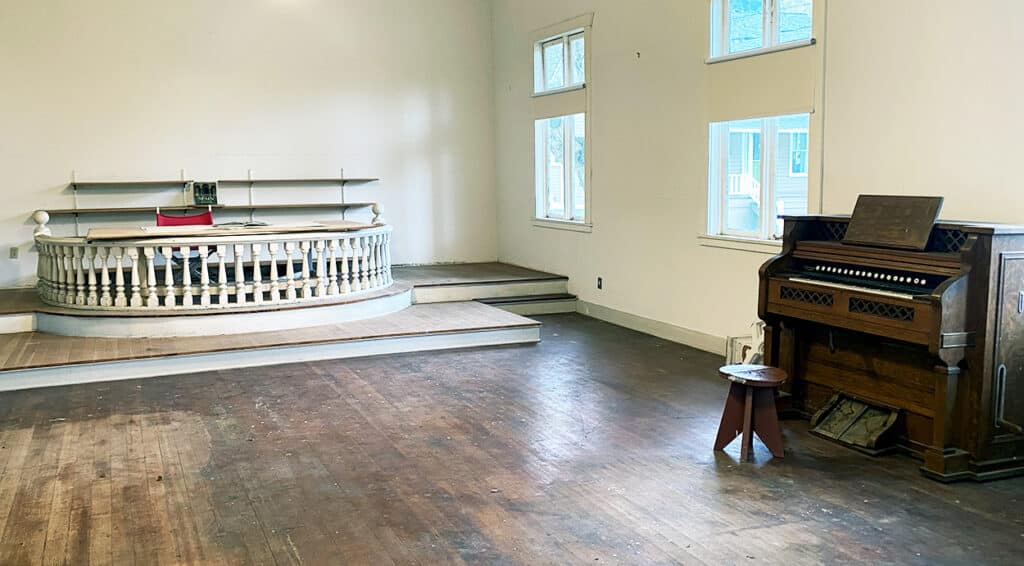
The great room in the formerd First Norwegian Lutheran Church of Gig Harbor (also called First Lutheran Church of Gig Harbor) still has the pulpit and an organ from its days as a place of worship. Christina T Henry
Knapp’s “A History of Peninsula Lutheran Church 1904-1979” (and a 75th PLC anniversary pamphlet by the same name) taps a trove of written documents and oral histories to trace the evolution of Lutheran congregations in Gig Harbor and vicinity.
The story that follows cites information from Knapp’s book and pamphlet.
Church seeds planted
In the early 20th century, when the church in Crescent Valley was built, the seeds of the Lutheran congregation who would occupy it were just being planted.
Norwegian and Swedish immigrants who settled in what is now the greater Gig Harbor area practiced their Lutheran faith with the help of itinerant pastors who served budding flocks around the sound.
Roads at the time were rough or nonexistent. Travel in the early 1900s was primarily by ferry to community docks on local waterways. The faithful counted themselves lucky to have services once or twice a month (if that), typically in a member’s home, a schoolhouse or other location.
One of those roving pastors, O.E. Heimdahl of Tacoma, described in his memoir how he met his prospective flock, which became First Lutheran.
“How I happened to take up church work in Gig Harbor I do not now remember,” he wrote in 1943. “Be that as it may, Monday morning May 25, 1908, the little steamer Crest brought me to that charming community.”
Scandinavian roots
Thus, Heimdahl began his outreach to people in the settlement, starting with the Uddenbergs, who owned a store near the wharf.
“The first service was held at 11 o’clock, Trinity Sunday, June 14, 1908,” Heimdahl wrote. “I do not recollect WHERE the service was held, but I remember that I used gown and collar to show the people that I was a REAL Norwegian Lutheran minister and not some kind of sectarian.”
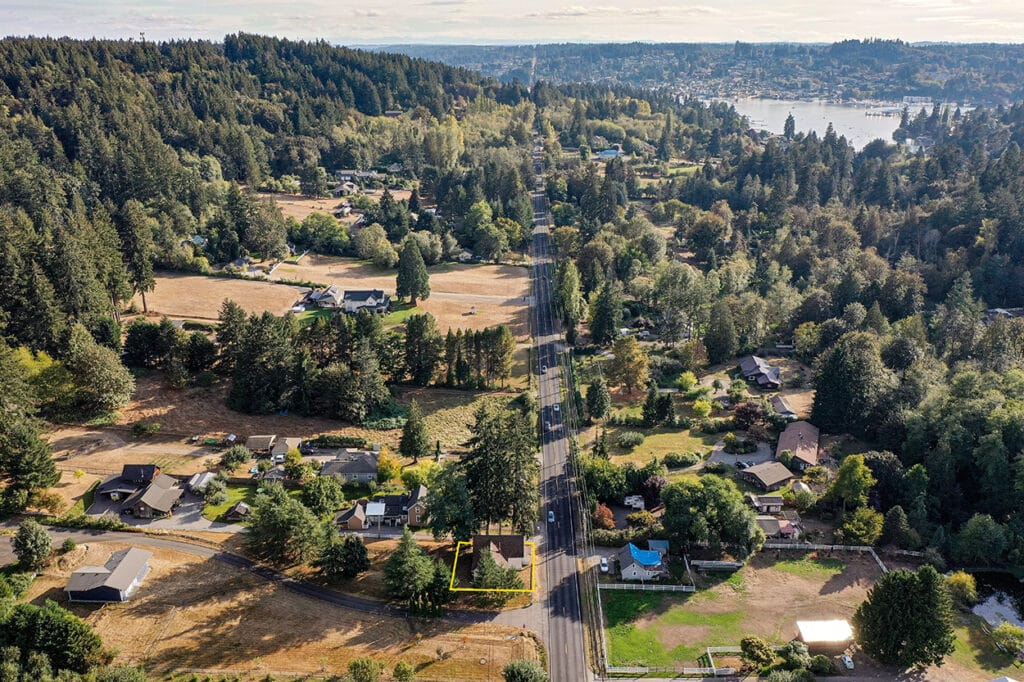
An aerial view of Crescent Valley shows the old First Norwegian Lutheran Church of Gig Harbor (also called First Lutheran Church of Gig Harbor) outlined in yellow. The former church property, which has been used as an art studio, is for sale. Michael Esteb, Windermere Gig Harbor
Early services in Lutheran congregations were conducted in Norwegian and sometimes Swedish. The gradual switch to English over a couple of decades was difficult for some, especially older members.
The first service in English for First Lutheran was held Sept. 18, 1910, according to Heimdahl, who served throughout 1908 and again from 1910-11. But that by no means spelled the end of services in the mother tongue.
The Rev. Raymond O. Overgaard, who served Gig Harbor’s Lutheran congregations from 1928-31, recalls “Old Mr. Berntsen” of the church in Cromwell lecturing him sharply (not in English), “We want Norwegian here and English once in a while!” To which poor Overgaard meekly replied, “Ja.”
The Ladies’ Aid
First Lutheran can thank the First Lutheran Ladies’ Aid of Gig Harbor for fundraising that helped with operations, including Sunday school, missionary work and the pastor’s salary.
When Pastor Heimdahl returned in 1910, services were held twice a month. The Ladies Aid met once a month, and Heimdahl attended most meetings where “a good and friendly spirit always prevailed.”
Income for the group’s contributions “was secured through the making of rugs, quilts and fancywork, the selling of Christmas cards, giving of suppers and the accepting of 20-cent dues and gifts,” according to a history of the Ladies’ Aid by Mrs. Rolf Brandt, written in 1945 and cited by Knapp.
“We pray God for eyes enlightened to see the open door, and burning wills and flaming minds to fulfill the privileges of our high calling in Jesus Christ,” wrote Brandt.
The Ladies’ Aid was also instrumental in fundraising for a church building.
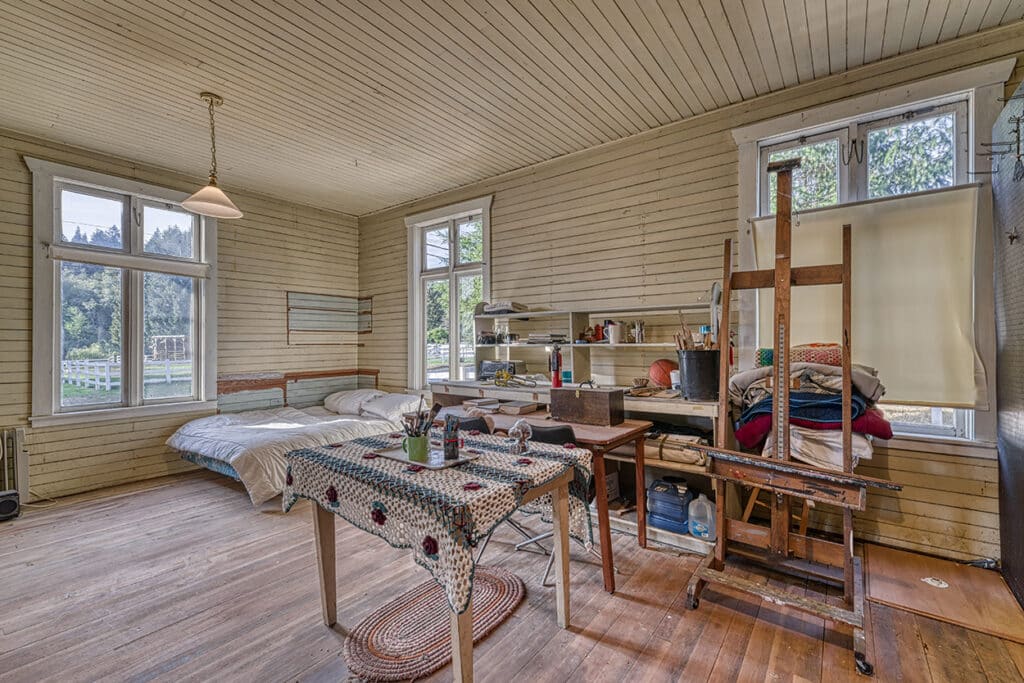
The former Sunday school room of the property that was the First Norwegian Lutheran Church of Gig Harbor (also called First Lutheran Church of Gig Harbor) has been transformed into an artist’s studio. The current owner and two previous owners have used the building as an art studio. The property is for sale; its listing price is $175,000 Michael Esteb, Windermere Gig Harbor
Finding their church home, 1926
The First Lutheran congregation incorporated on March 20, 1913, with the intent of purchasing property for a church to call their home. With help from the Ladies’ Aid, they put $50 down on two lots, to be the site of the new building.
Progress came to a standstill shortly afterward, however. There are no congregational records from 1913-’23, and activities of the Ladies Aid “kind of died down for a while,” recalls Martha (Kahrs) Alvestad, interviewed for Knapp’s book.
In the early 1920s, the congregation reawakened. Services were held in the Methodist church, but “there were continuing clashes with the Methodists over the amount of rent charged for the use of their church,” according to Knapp.
Finally, in 1926, the two lots were sold and proceeds put toward purchase of the Nazarene Church in Crescent Valley. After “incessant haggling,” the two congregations finally settled on a price of $561. “The first meeting was joyfully held in the church on Feb. 21, 1926,” Knapp wrote.
Life in the valley, 1930s
The little church was a spiritual gathering place for Crescent Valley’s farming community. Some members walked miles to attend meetings, according to the Ladies Aid history.
The church “found the homes of its members stretched in a single file of chicken ranches and truck farms about two miles long with the church building in the center. To the north stretched a wilderness almost unbroken at that time,” Brandt wrote.
Men of the congregation worked multiple jobs with the seasons, fishing or logging in addition to farming. Most of the men were at sea half the year.
In 1934, the church sustained damage from a gale force windstorm and required extensive repairs. The Sunday school wing was added in 1935. Pews were purchased and the Ladies’ Aid funded a new oil heater. In 1937, the church was painted.
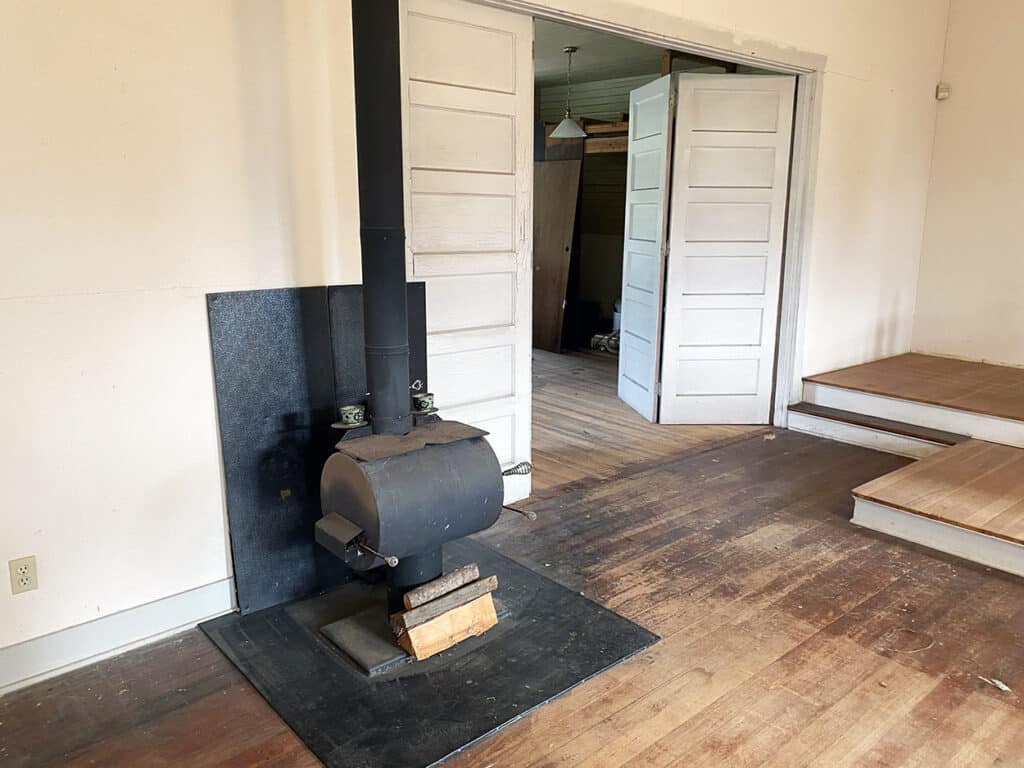
A functioning wood-burning stove in the great room (previously the sanctuary) of the former First Norwegian Lutheran Church of Gig Harbor (also called First Lutheran Church of Gig Harbor). Christina T Henry
Lutefisk suppers and smorgasbord
In 1939 and ‘40, the congregation was rebounding from the Great Depression and growing. The Ladies’ Aid held lutefisk suppers, smorgasbord buffets and chicken dinners, among other endeavors.
For lutefisk, the men went to Tacoma and got the fish box. The women cut up the fish and prepared it in the old way.
“I tell the women now, they don’t know what work is!” said Martha Alvestad, in her interview. “We had to soak out the lye, or whatever was used, for three days. It was usually held in December or maybe the first part of January, so we had lots of cold fingers.”
Those feasts were suspended during the World War II “due to the scarcity of butter and other banquet necessities,” according to Brandt.
Congregation consolidation, 1934
First Lutheran Church of Gig Harbor was one of four congregations that merged in the early 1950s to form Peninsula Lutheran Church. The march toward that union began in the 1930s, as the four small churches struggled during the Depression, among other issues.
Of the four, Immanuel Lutheran Church of Cromwell was the largest and most vibrant with about 100 members. First Lutheran was half that size and the other two — First Evangelical Lutheran Church of Olalla and and Bethel Lutheran Church of Wollochet — were much smaller.
The four churches in January 1934 formed the Peninsula Lutheran Parish Association with the primary goal of providing a parsonage for the one pastor who served them all.
The association helped the separate but united congregations weather the Depression and laid the foundation for later unification as a single congregation.
Church merger, 1952
World War II and its aftermath brought prosperity and changing lifestyles to the Gig Harbor area. Automobiles became more common; more roads were built and improved. Ferries had lost their place as the primary means of transportation. That left the rural churches, situated on or near the water, geographically isolated.
Cromwell and First Lutheran began discussing a more central, shared location, an idea which solidified at a Luther League meeting of both congregations in January 1950.
On Jan. 8, 1951, First Lutheran voted to consolidate with Immanuel Lutheran. Immanuel ratified the consolidation in February. The two congregations met April 16, 1951, to establish their new organization, Peninsula Lutheran Church. In May 1951, they bought three acres on the “Tacoma-Bremerton Highway,” now Highway 16.
From July through September 1951, both congregations met at First Lutheran while the church building at Cromwell was moved in three pieces to the new Peninsula Lutheran site — quite the undertaking.
An artist’s haven
The last worship service at First Lutheran Church was on Sept. 14, 1952. The first service of Peninsula Lutheran at its current site was on Sept. 21, 1952.
The congregations at Olalla and Wollochet became absorbed into Peninsula Lutheran over time. The Cromwell church building has since been replaced by the current Peninsula Lutheran sanctuary.
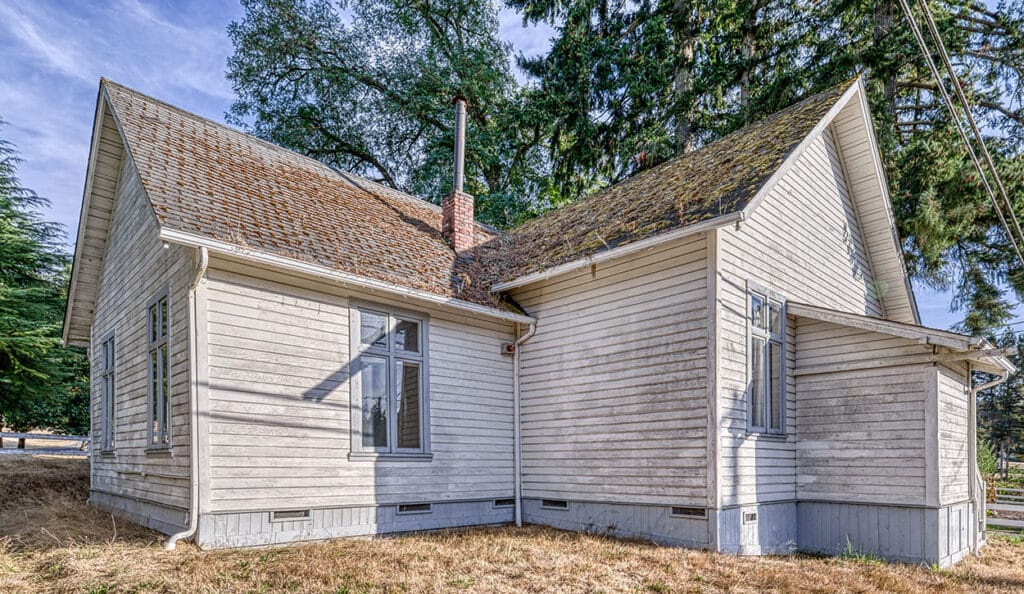
The former First Norwegian Lutheran Church of Gig Harbor (also called First Lutheran Church of Gig Harbor) is for sale. Built in 1908, the church was occupied by two congregations. Since 1953, it’s been used by three separate owners as an artist’s studio. The listing price is $175,000. Michael Esteb, Windermere Gig Harbor
Following the merger, the First Lutheran Church building was sold to Douglas Knapp’s uncles, Calvin and Byron Knapp, whose family were members of First Lutheran.
According to a recent title search conducted by Knapp, the little church was sold on Aug. 1, 1953. The purchase price was $1,500.
Calvin Knapp, a professional musician, played the organ at First Lutheran and was the organist and choir director at Peninsula Lutheran through 1961. Byron had a career in real estate and was an also an artist. He used the church as a studio and gave art lessons there into the 1970s, according to Knapp.
Byron died in 1983, and the church was sold in the fall of 1985 to Jeanne Willis-Long and George W. Long, also both artists. They met while both were shopping for art supplies and subsequently moved to Gig Harbor, where they “started a studio in an old church,” according to Jeanne’s obituary.
“It has an energy about it”
Following George’s death, Jeanne Willis-Long sold the church to Diane Davis in November 1995.
Davis, whose son owned a home on Crescent Valley Drive, remembers driving by the old church.
“I said to my son, ‘Who’s the lucky person who owns that? And shortly after that, it would be mine,” she said.
Willis-Long was sad to see it go.
“She said when she sold the church to me, she cried,” Davis said.
And her own feelings for the place are equally profound.
“It has an energy about it, and I can’t quite describe it. But there was something special about it,” she said. “It’s hard to put into words when you love something, right?”
Over the years, people have shared with Davis their memories of the church.
“I have received letters from many people telling me their grandparents were married there, their great-grandmothers went to Sunday school there,” she said.
Davis has enjoyed many hours in the church creating her art. She reiterated her hope that the next owner — “someone who sees the great potential and who respects history” — will honor its past and enjoy its presence as she and others have done throughout the decades.

